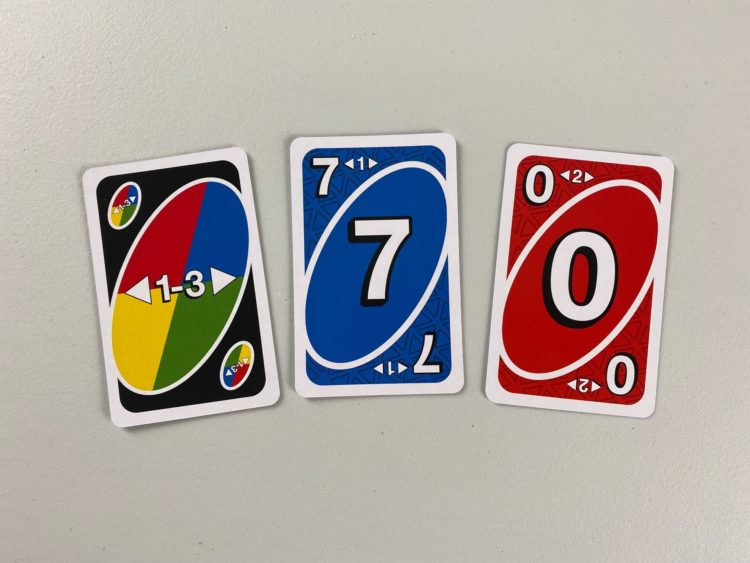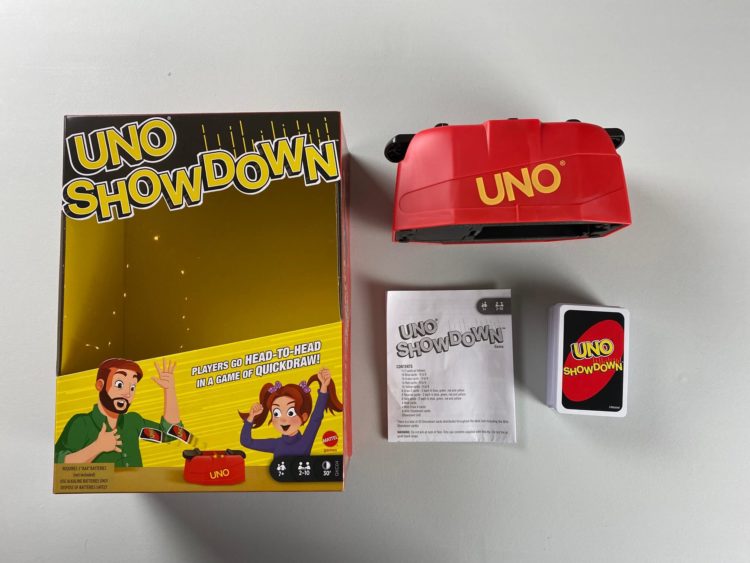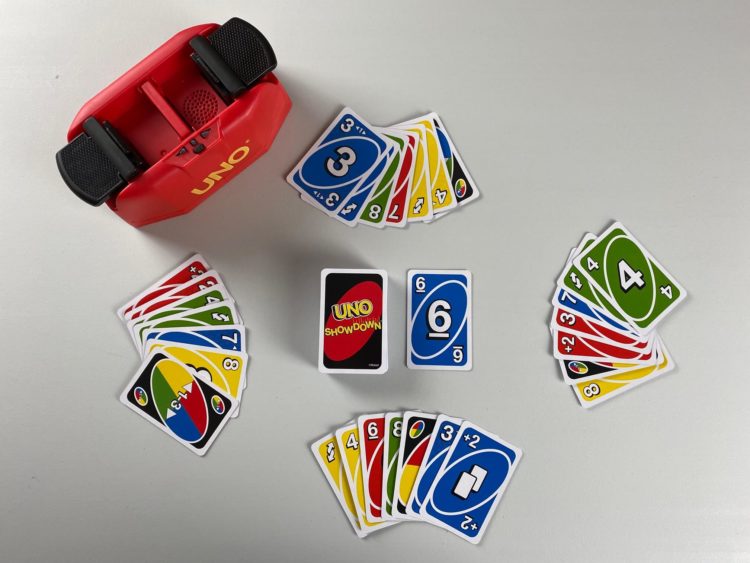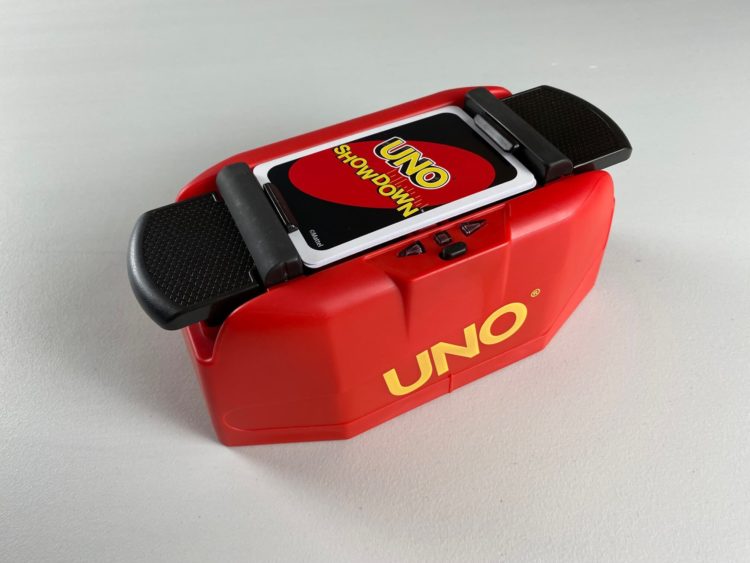
OBJECTIVE OF UNO SHOWDOWN: Be the first player to empty their hand each round, and the first to reach 500 points to win the game
NUMBER OF PLAYERS: 2 – 10 Players
CONTENTS: 112 Cards, 1 Showdown Unit
TYPE OF GAME: Hand Shedding Card Game
AUDIENCE: Ages 7+
INTRODUCTION OF UNO SHOWDOWN
UNO Showdown is a new way to play the classic game. During each round, players are trying to get rid of all the cards from their hand. They can play cards to the discard pile that match by color, number, or action. The first player to get rid of all the cards from their hand wins the round and earns points based on what is remaining in their opponents’ hands. The first player to earn 500 points wins the game.
The twist for UNO Showdown is the addition of the Showdown Unit. Twenty-four of the cards in the deck initiate a showdown when played. A certain number of cards are inserted into the Showdown Unit, and a timer counts down. At the end of the timer, the player who slams their paddle first will win the showdown and cause the cards to fly at their opponent. You have to be quick in this game!
CONTENTS
The game includes a 112 card deck. All of the classic UNO cards are there along with the addition of the new Wild Showdown Card. Twenty of the cards also include a showdown symbol. Whenever one of these cards (or the Wild Showdown Card) is played, a Showdown is initiated between the person who played the card and the next player in turn order.

The deck contains four colors: blue, green, red, and yellow. There is also a group of WILD cards. Each color has two copies of numbers 1 – 9 and one copy of the number 0. They also have two copies of the Draw Two card, the Reverse card, and the Skip card.
There are twelve WILD cards in the deck. The four WILDS allow players to choose a new color that must be played. The four WILD Draw Four cards force the next player to draw four cards from the draw pile and lose their turn. The player who played the card also gets to pick the color that must be followed. The 4 new WILD Showdown cards allow a player to pick the color that must be followed, the player they will have a showdown with, and the number of penalty cards on the line for the showdown.
The other new addition to this version of UNO is the Showdown Unit. Anytime a showdown card is played, the unit will be used. Cards are loaded into the unit, and a timer button is pressed to initiate the countdown. Both players wait with their hands on their paddle, and once the timer goes off, the faster player will send the cards flying toward their opponent.

SETUP
Place the Showdown Unit in the center of the playing space. Shuffle the deck and deal 7 cards to each player. The rest of the deck is a draw pile, and it is placed face down in the center of the table as well.
Turn the top card of the draw pile over to begin the discard pile.

THE PLAY
The player seated left of the dealer goes first. To play a card from their hand, they must match the color, number, or action of the card showing on top of the discard pile. The player can also play a WILD card if they choose.
If a player cannot play a card, they draw one from the draw pile. If that card can be played, the player may do so. If it cannot be played, their turn ends and play passes to the next player. A player is not required to play a card on their turn if they have one that can be played. A player may choose to draw instead.
ACTION CARDS
All of the classic action cards are here. The Draw Two forces the next player to draw two cards from the draw pile and miss their turn. They cannot play a card. The Reverse card changes the direction of play. The Skip card forces the next player to miss their turn.
WILD CARDS
When a WILD is played, that player chooses the color that the next player must follow. The WILD Draw Four allows the player to do the same, but it also forces the next person to draw four cards from the draw pile.
The WILD Showdown card allows the player to pick the next color that must be followed, the opponent that will enter the showdown with them, and how many cards are put in the Showdown Unit.
SHOWDOWNS
Whenever a card with a showdown symbol or a WILD Showdown card is played, a showdown is initiated.
When a color card with the showdown symbol is played, a showdown occurs between that player and the next opponent in the turn order. Place the unit between the two players, load the number of cards determined by the showdown symbol, and push the timer button on the unit. Each player should place their hands on their paddle. The unit will begin a countdown, and once the countdown ends, both players will press their paddle as quickly as they can. The winner will send the cards flying towards their opponent.
If it is too hard to tell which opponent lost the showdown, use the lines on the side of the unit. Whichever player has more cards on their side of the unit loses.
If a player presses their paddle before the timer ends, the until will end the countdown and the red arrow will point at the player who pushed it too soon. They automatically lose the showdown and take the cards.

ENDING THE ROUND
When a player plays their second to last card, they must say UNO. If they fail to do so, and an opponent says it first, that player must draw two car
When the final card is played from a person’s hand, they win the round. If the final card is a showdown card, a showdown must occur.
Once a player completely empties their hand, the round ends. Tally up the score for the round, collect the cards, and pass the deal left each round.
SCORING
The player who emptied their hand earns points based on the cards remaining in their opponents’ hands.
Number cards are worth the value of the number on the card. Draw Two’s, Reverses, and Skips are worth 20 points. WILD Showdown cards are worth 40 points. WILDs and WILD Draw Fours are worth 50 points each.
WINNING
Play continues until one person reaches 500 points or more. That player is the winner.
- TRIPLE SNAKES - February 15, 2021